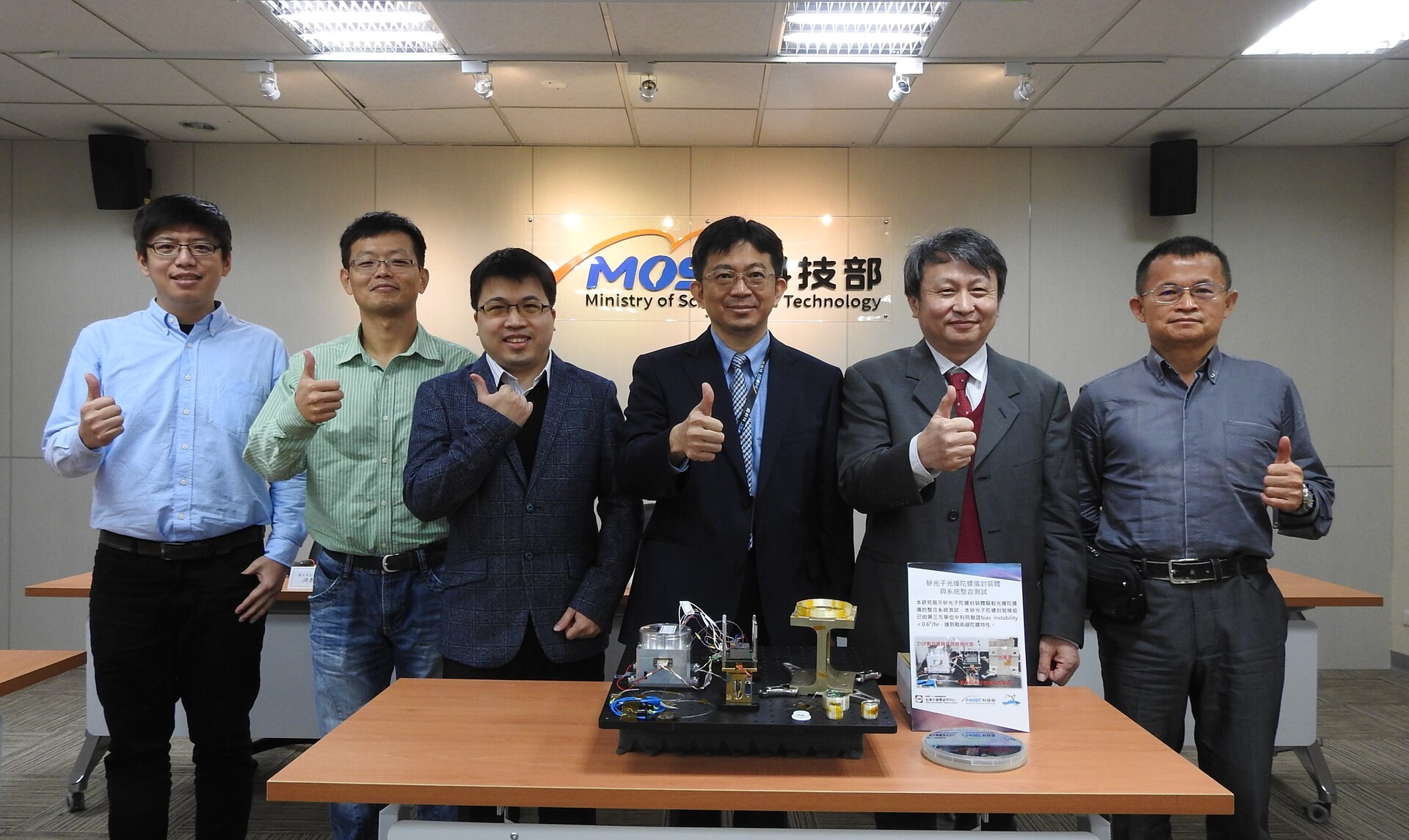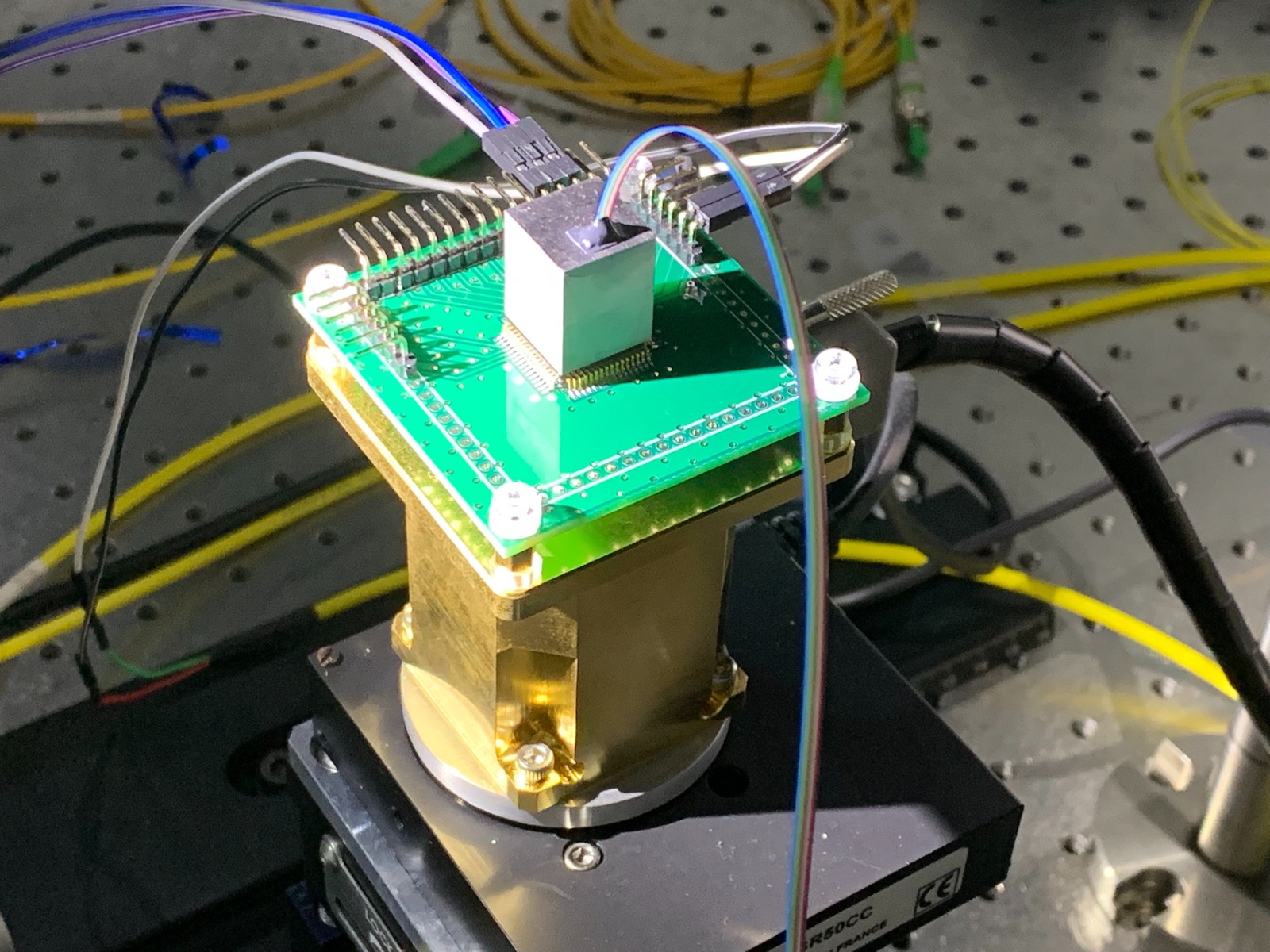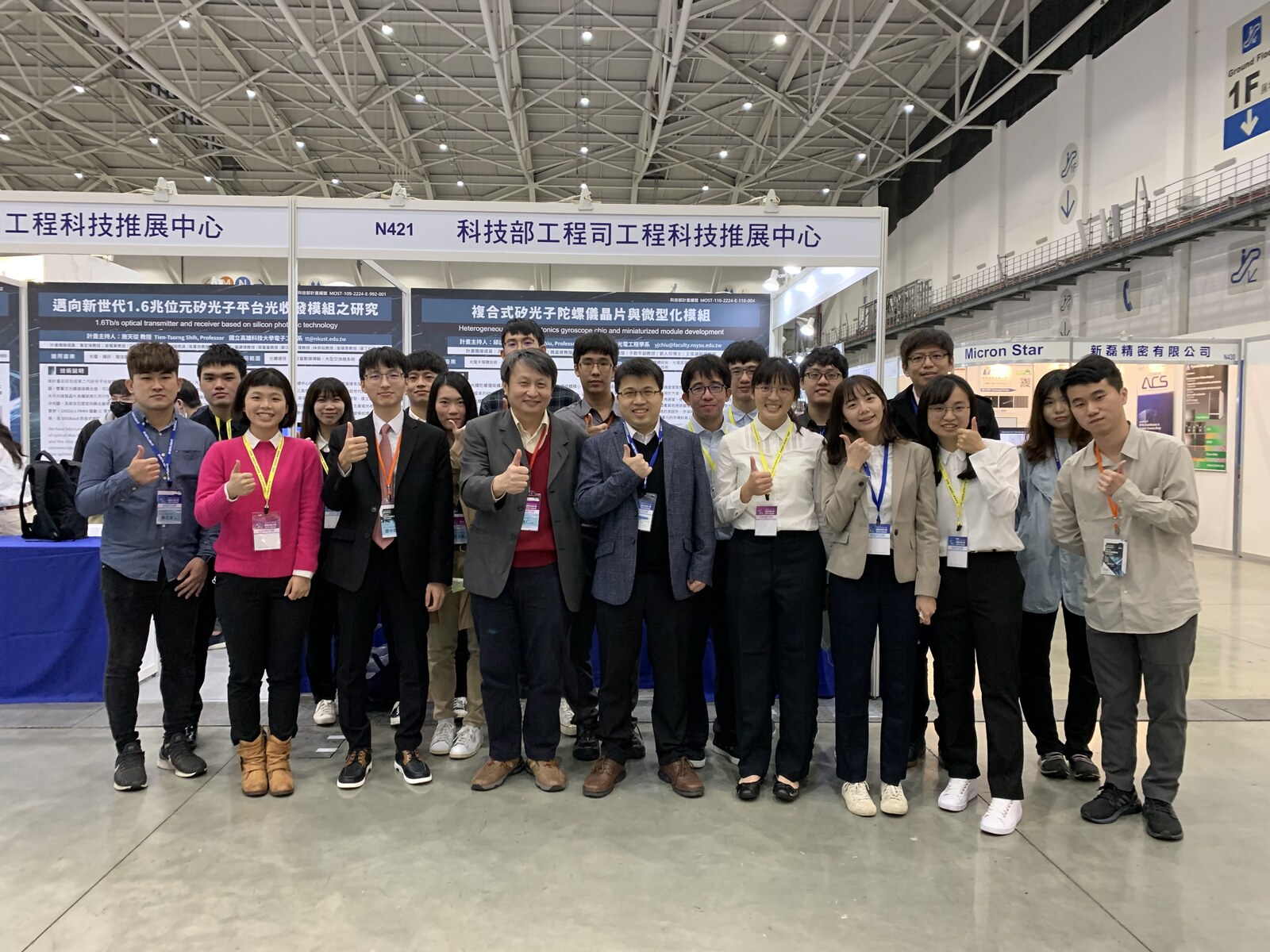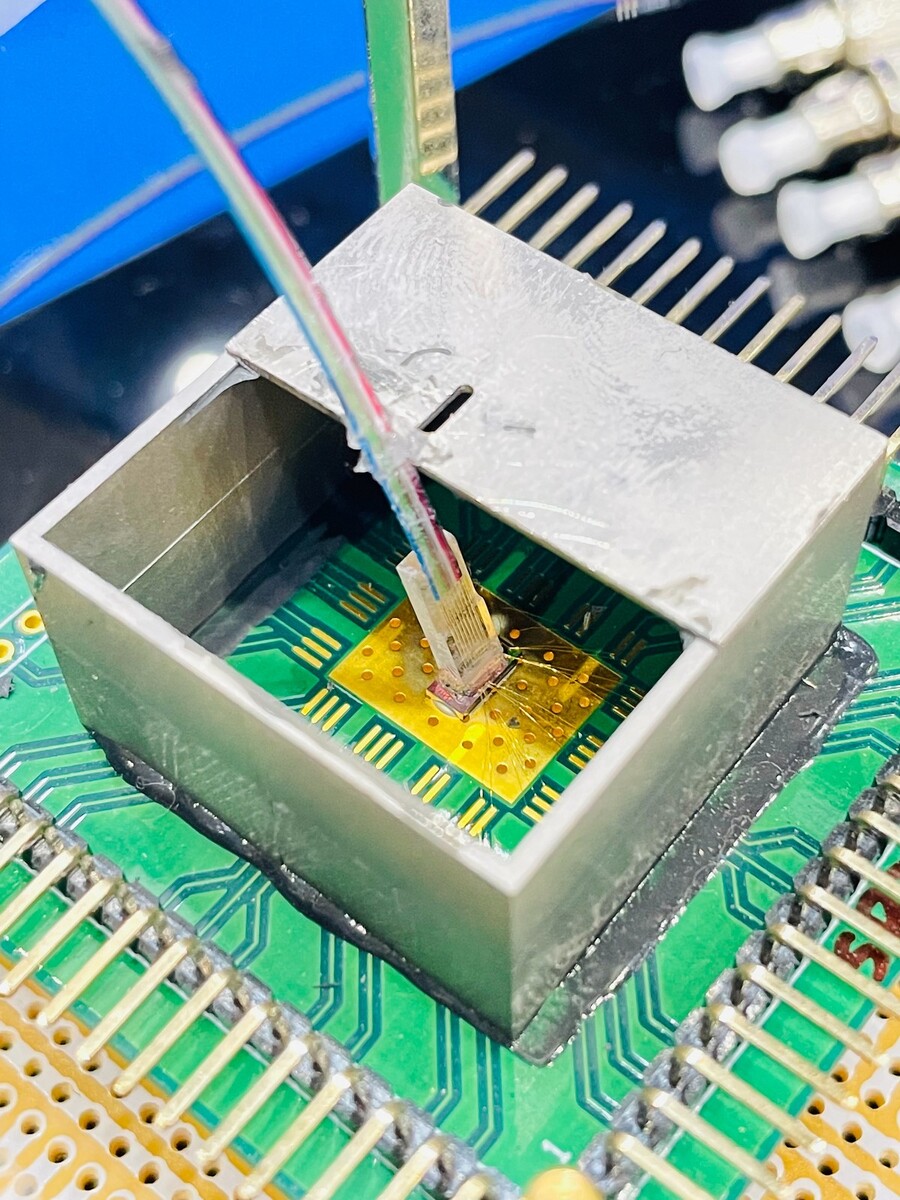New solution of advanced positioning technology: millimeter-size Si photonics fiber optics gyroscope chip




2021-12-28
Taiwan has been known as the global leader in semiconductor production and processing, which mature supply chain has already achieved different levels of relevant technologies and applications. In the last decade, the invention of silicon (Si) photonics has led to the advancement of photonics integration circuit by using semiconductor manufacture production line, allowing the advantages of multi-functional and cost-effective optical signal processing techniques, such as broadband, high resolution, low power consumption and low EM interference, to be built inside a small chip.
Following this trend in technology, the Ministry of Science and Technology (MOST) of Taiwan has promoted Si photonics development since 2018. Si photonic fiber gyroscope project, led by Professor Yi-Jen Chiu of the Department of Photonics at National Sun Yat-sen University, was one of the funded projects. The team used several new designs of optical and electrical circuits in Si photonic integration chip, not only reducing the overall size of the chip but also setting a new level of angular velocity sensing capability. A tactical level of sensing capability has been demonstrated through employing such silicon photonic gyro chip. The integration of optical elements in the chip has decreased the cost of the conventional interferometer fiber optical gyroscope by approximately one third. The design of Si photonic gyro chip did not only level up the gyro function but also brought new and multiple functions in a chip. For example, more functions besides the conventional gyro elements can be installed in a mm-scale chip, enabling sensing and configuring capabilities. The unmanned vehicle and aerial camera with such light sensing tool can be made with a stabilizer. In addition, the Si photonics gyroscope also has a great potential for consumer purposes: in bio engineering, autonomous cars, robot, navigation, and CubeSat.
Interferometric fiber optical gyroscope (IFOG) is one of the indispensable components for sensing angular velocity in medium- and high-end navigation systems, such as aerospace, underwater and unmanned vehicles. Ring laser gyroscope (RLG) and hemispherical resonant gyroscope (HRG) are the most stable and highest-resolution types of gyroscope to the record now, however, the complicated structure needs delicate assembly engineering, resulting in high cost. On the other hand, microelectromechanical system (MEMS) gyroscope fabricated in semiconductor foundry can be adapted to the mass production line, thus achieving the lowest cost per piece. Nevertheless, the mechanical properties render it to be low precision from up-to-date technologies. As for gyroscope performance, IFOG modules could vary from high-end to medium-end, depending on the design and assembly technologies. With the promotion of Si photonic technologies, photonics integration offers an excellent solution for future gyroscope and related technologies.
The team of Si photonic gyroscope project at NSYSU Department of Photonics has been funded by MOST for 4 years. The team includes former Chair of NSYSU Department of Photonics Professor Yi-Jen Chiu as the principal investigator (PI), also responsible for developing broadband light source of gyroscope, an expert in fiber-optic gyroscope Dr. Jen-Yang Liu, and a Si photonic expert Professor Yung-Jr Hung as Co-PIs; several industrial partners have collaborated with the project. To develop a gyroscope package and its driving circuit, Professor Chua-Chin Wang of the Department of Electrical Engineering, NSYSU, an expert in integrated circuits, was also invited to develop closed-loop electronic circuit chips. The silicon photonic gyroscopic chips were jointly designed, developed, and characterized by professors Chin-Ping Yu, Tsung-Hsien Lin, Yung-Jr Hung, and Chun-Ta Wang of the Department of Photonics; the research on low-loss optical waveguide coils was led by Professor Chao-Kuei Lee and Professor Chun-Ta Wang. To improve the signal-to-noise ratio in optical signal processing, the noise-reduction technology in optical waveguide was led by Professor Chia-Chien Wei. In the past three years, they attained excellent research work and Si photonic IFOG submodule, including patents, participation in a top international conference, and a journal paper publication.
Taiwan has been known as the global leader in semiconductor production and processing, which mature supply chain has already achieved different levels of relevant technologies and applications. In the last decade, the invention of silicon (Si) photonics has led to the advancement of photonics integration circuit by using semiconductor manufacture production line, allowing the advantages of multi-functional and cost-effective optical signal processing techniques, such as broadband, high resolution, low power consumption and low EM interference, to be built inside a small chip.
Following this trend in technology, the Ministry of Science and Technology (MOST) of Taiwan has promoted Si photonics development since 2018. Si photonic fiber gyroscope project, led by Professor Yi-Jen Chiu of the Department of Photonics at National Sun Yat-sen University, was one of the funded projects. The team used several new designs of optical and electrical circuits in Si photonic integration chip, not only reducing the overall size of the chip but also setting a new level of angular velocity sensing capability. A tactical level of sensing capability has been demonstrated through employing such silicon photonic gyro chip. The integration of optical elements in the chip has decreased the cost of the conventional interferometer fiber optical gyroscope by approximately one third. The design of Si photonic gyro chip did not only level up the gyro function but also brought new and multiple functions in a chip. For example, more functions besides the conventional gyro elements can be installed in a mm-scale chip, enabling sensing and configuring capabilities. The unmanned vehicle and aerial camera with such light sensing tool can be made with a stabilizer. In addition, the Si photonics gyroscope also has a great potential for consumer purposes: in bio engineering, autonomous cars, robot, navigation, and CubeSat.
Interferometric fiber optical gyroscope (IFOG) is one of the indispensable components for sensing angular velocity in medium- and high-end navigation systems, such as aerospace, underwater and unmanned vehicles. Ring laser gyroscope (RLG) and hemispherical resonant gyroscope (HRG) are the most stable and highest-resolution types of gyroscope to the record now, however, the complicated structure needs delicate assembly engineering, resulting in high cost. On the other hand, microelectromechanical system (MEMS) gyroscope fabricated in semiconductor foundry can be adapted to the mass production line, thus achieving the lowest cost per piece. Nevertheless, the mechanical properties render it to be low precision from up-to-date technologies. As for gyroscope performance, IFOG modules could vary from high-end to medium-end, depending on the design and assembly technologies. With the promotion of Si photonic technologies, photonics integration offers an excellent solution for future gyroscope and related technologies.
The team of Si photonic gyroscope project at NSYSU Department of Photonics has been funded by MOST for 4 years. The team includes former Chair of NSYSU Department of Photonics Professor Yi-Jen Chiu as the principal investigator (PI), also responsible for developing broadband light source of gyroscope, an expert in fiber-optic gyroscope Dr. Jen-Yang Liu, and a Si photonic expert Professor Yung-Jr Hung as Co-PIs; several industrial partners have collaborated with the project. To develop a gyroscope package and its driving circuit, Professor Chua-Chin Wang of the Department of Electrical Engineering, NSYSU, an expert in integrated circuits, was also invited to develop closed-loop electronic circuit chips. The silicon photonic gyroscopic chips were jointly designed, developed, and characterized by professors Chin-Ping Yu, Tsung-Hsien Lin, Yung-Jr Hung, and Chun-Ta Wang of the Department of Photonics; the research on low-loss optical waveguide coils was led by Professor Chao-Kuei Lee and Professor Chun-Ta Wang. To improve the signal-to-noise ratio in optical signal processing, the noise-reduction technology in optical waveguide was led by Professor Chia-Chien Wei. In the past three years, they attained excellent research work and Si photonic IFOG submodule, including patents, participation in a top international conference, and a journal paper publication.
Click Num:
Share
